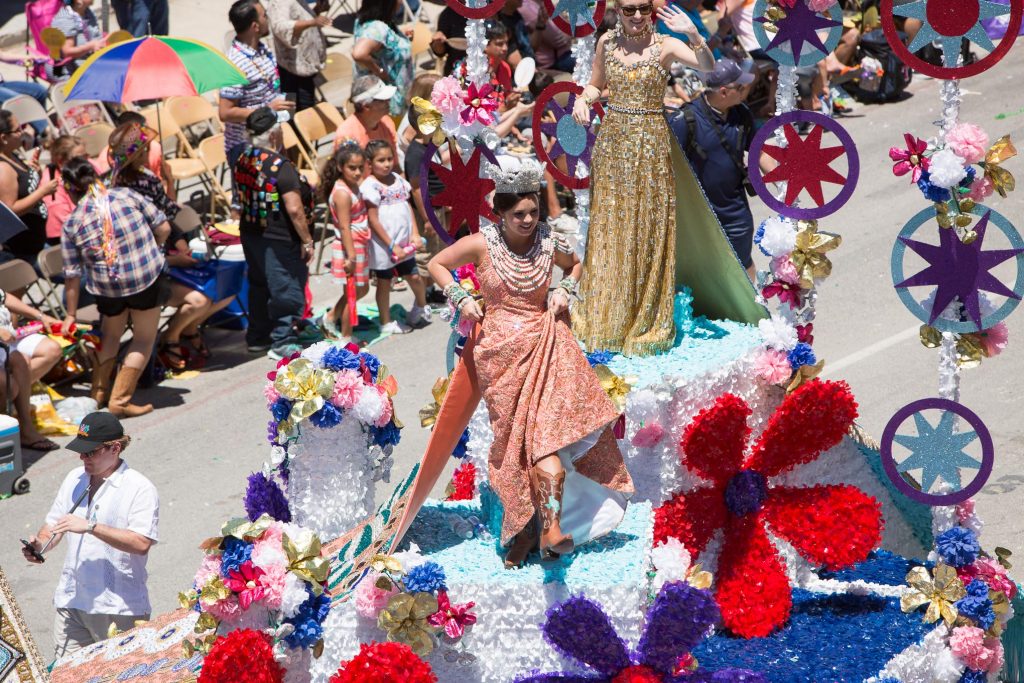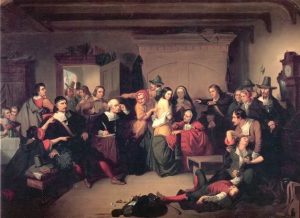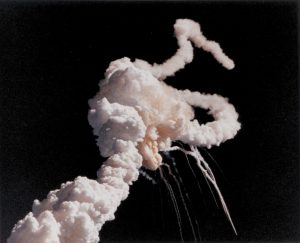Colorful floats; streets closed with barricades; people covering the sidewalks and setting up their lawn chairs to have a good view, having the day off from school; the Marching Bands from High Schools and Universities, decorating their instruments with ribbons, preparing their formation under Highway 37 on Grayson Street; the Fiesta Royalty putting on their best pairs of decorated shoes before stepping onto their throne, mounted on one of the biggest of the parade floats. If you’re a native San Antonian, you know exactly what grand celebration is about occur and what has been going on for the days before; it is part of Fiesta, the ten-day city-wide celebration; it is the Battle of Flowers parade. The Battle of Flowers is a 2.6-mile parade that runs through downtown San Antonio, typically one of the closing events of the Fiesta celebration. This Parades begins on the edge of downtown, and continues onto three major streets: Broadway, Alamo, and Commerce.1 Local schools participate in this parade; their dance troops, mariachi bands, ROTC, and Marching Band programs participate and walk the parade alongside the Texas Cavaliers, the Fiesta Royalty, and the Mayor. Although this annual event has become a hallmark for San Antonians, many don’t know how or when it all began. Let’s go back to its origins, back to the last decade of the nineteenth century in San Antonio.

Originating in 1891, the Battle of Flowers parade was created as a tribute to all those who fought and who fell at the Battles of San Jacinto and the Alamo.2 The idea of a grand celebration to commemorate these heroes came from a tourist, the native-Chicagoan W. J. Ballard. He believed that a proper tribute should be made, and asked a group of local ladies why this had not been the case just yet. His question extended through the city and made its way into newspapers and gained the approval of the community almost instantly. The anticipated idea aroused a spark of interest in Ellen Maury Slayden, a native Virginian elite, who had found her way to San Antonio by marriage to a merchant and later congressman, James L Slayden. Slayden then decided to bring Ballard’s idea to life, and since she knew it was almost impossible on her own, she decided to enlist the help of another newcomer to the area, J. S. Alexander. They both decided to take this on as a pet project of theirs, with the help and support of their husbands. Alexander, a banker before arriving in Texas, provided information on some familiarity he had had overseas about seeing a parade surrounded by flowers, where carts were decorated with flowers. Slayden also remembered similar instances in celebrations she knew about across Mexico and Spain, giving the basis for what the parade would become. The husbands, and many of the elite men of San Antonio, took over the project and had gentlemen speak on behalf of the ladies at the committee meetings; however, as the project grew, the ladies wanted to make sure that it was still a women’s project and continued to provide input and ideas, thus creating the Battle of Flowers Association.3

The parade was originally intended to be an April 21st celebration to celebrate the 55th anniversary of the victory of the Battle of San Jacinto; however, coincidentally, San Antonio was just then expecting its first-ever visit from the White House, the 23rd president of the United States, President Benjamin Harrison. As soon as word got out, the city became ecstatic and prepared a celebration to welcome the President, including moving the parade a day ahead of its original date. With the dates set in stone, the first official planning committee meeting took place only a mere seven days prior to the event. They were frantically trying to gather flowers from nearby towns, since San Antonio had just experienced some heavy rains, which had destroyed most flower gardens, leaving the city with a shortage of flowers just before the parade. Trains were rushed in with shipments of flowers from nearby towns. Other means of making up for the shortage were discussed as well, such as dressing the children up as flowers and having bicyclists decorate their mobiles with whatever blossoms they found and join the parade.4 In the days leading up to the parade, everything seemed all set to go, except for the weather. The city had been plagued with days of heavy rain, and the whole city was hopeful that the rains would cease as the day approached; however, they were wrong. On the morning of the parade, the rains didn’t have mercy on their plans, and as the President’s train arrived, the downpour became continuous. But the rains didn’t stop the city from providing the President with a warm welcome; however, it did postpone the flower parade for the following week, which, of course, would mean that the President would be long gone by then. When the warm weather finally arrived the following week, the parade went as planned; and it was so successful that the committee pushed to have it continue as an annual celebration. It has since been celebrated since 1891, except for the years during World Wars I and II.5

By 1985, the parade continued to grow into the week-long celebration known today as Fiesta. And as the years went by, Kings and Queens were elected as Fiesta Royalty.6 The Parade continues to grow, and so does its recognition across the city and the state. It is now funded by private associations. To this day the parade is one of the closing events of the city-wide, week-long Fiesta party and continues to generate community involvement. Every April, San Antonio puts on a fantastic show, and without a doubt, it all goes back to a Chicagoan tourist, two ladies, and one united community.

- Battle of Flowers, Official Website: Battle of Flowers About us (battleoflfowers.org, 2018). ↵
- Handbook of Texas, June 2010, s.v “Fiesta San Antonio,” by Mrs. Willard E. Simpson, Jr. ↵
- Jack Maguire, A Century of Fiesta in San Antonio (Austin, Texas: Eakin Press, 1990), 13-15. ↵
- Jack Maguire, A Century of Fiesta in San Antonio (Austin, Texas: Eakin Press, 1990), 17. ↵
- Jack Maguire, A Century of Fiesta in San Antonio (Austin, Texas: Eakin Press, 1990), 17; Laura Hernandez-Ehrisman, Inventing the Fiesta City, Heritage and Carnival in San Antonio (New Mexico Press,2008), 21. ↵
- Handbook of Texas, June 2010, s.v. “Fiesta San Antonio,” by Willard E. Simpson, Jr. ↵



117 comments
Irene Astran
Thank you for this! I keep hearing about the Battle of Flowers and I know that campus offices close early because of this event, but I had no idea when I first came here what the big deal was about. I have not been to the parade, but upon reading your introduction, felt I could see myself there enjoying the day!
Vanessa Tombo
The diction, style, and structure of this article make it very easy for readers to enjoy this reading. The topic address is one that many celebrate but do not fully know the background history. This short article was extremely intriguing and educational for readers. While growing up in Texas I did not know that Battle of the flower parade was for all who fought in the Battles the Alamo and San Jacinto.
Peter Coons
As a stranger in a strange land, per say, I have always wondered what the fuss was about in regard to Fiesta and the various events. I go to the school that kicks off the whole event and still don’t know why oysters are the go to food for a landlocked city. I digress. The Battle of the Flowers always struck me as an odd thing to celebrate. Why host combat with flowers? Well, now I know that the event actually is far deeper and has a rich history, and without this article I’d probably still be in the dark.
Isaac Saenz
I have lived in San Antonio for most of my life but never knew the history of the Battle of Flowers parade. I also didn’t know that the president had come to visit, although he, unfortunately, wasn’t able to stay to see it through. It is always interesting to learn more about the city I live in and especially the history of Fiesta because of how big an event it is.
Monica Avila
As a San Antonio native, the Battle of the Flowers parade is nothing new to me. Fiesta has always been one of my favorite times of the year! From flower crowns to chicken on the stick, the Fiesta culture is deep within my family traditions. This article did a great job at capturing the true spirit and essence of the parade. The pictures were very colorful and great representations of how beautiful and crazy downtown gets during the parade.
Caroline Bush
Great article! I had heard about the Battle Of Flowers parade but I never knew the history behind this event before reading this article. I really enjoyed the pictures used in this article and thought that they gave the story an extra bit of flair. I really enjoyed reading about this parade because its coming up pretty soon and I was thinking about participating. Overall I really enjoyed this article and found the topic really interesting.
Maria Mancha
I read this article earlier in the semester. It truly outlines San Antonio and fiesta. Fiesta is such a big part of San Antonio spirit and culture. I am truly glad this article is up for nomination. It was extremely well written. It makes me even more excited for the more fiesta events that are coming soon this week and next!
Christopher King
This article explains a lot to me since I am not from San Antonio and never knew what anyone was talking about when they talked about the Battle of the Flowers parade. I find it strange that a tourist is the one who came up with the idea of celebrating the battles at San Jacento and The Alamo. I enjoyed this article because of the fact that a tourist came up with the idea and that the women fought to have control over this event. This article is well written and reveals the different influences the parade had from the beginning. The Mexican culture involved reveals the San Antonio spirit in the celebrations.
Marlene Lozano
With living in San Antonio, I am very familiar with fiesta and the Battle of Flowers parade but I never fully knew the backstory behind the parade. The parade itself is a big part of San Antonio’s culture and fiesta that is able to bring people from all over the city to help celebrate. The images used in this article are amazing.
Belia Camarena
I am from San Antonio, and fiesta is one of my favorite times of the year. For this reason, I was immediately drawn to this article. I really enjoyed reading this because I always attend Battle of the Flowers, but I never knew what this parade is actually about. The author did a great job writing it. It was entertaining, informative and the featured image is vivid. I can definitely see why this article was chosen as a nominee for best use of images.